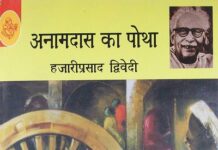On the world book day, I asked my Twitter and FB friends and followers to suggest me some books from Indian languages. Aavarana by Sh S L Bhyrappa in Kannada was the top suggestion. I looked for translations in Hindi and English, thankfully the book is available in both languages and many more Indian languages. I wanted to read it in Hindi.
 This time instead of buying the book, I picked it up from my public library. I strongly suggest you visit your local library and start looking for books you want to read. This is how you can reduce your carbon footprint.
This time instead of buying the book, I picked it up from my public library. I strongly suggest you visit your local library and start looking for books you want to read. This is how you can reduce your carbon footprint.
The book begins with the story of a filmmaker couple from Bangalore on a trip to make a film on Hampi. The woman here is the main protagonist of the story. From Hampi, the story goes back and forth in time and you travel with her to her personal past and her past that is also our collective past.
Read Aavarana The Veil by Bhyrappa: English, Marathi or Hindi
It is a story of a girl who changes her religion to get married and cuts off her ties with her father who lives in a village in Karnataka. After the father passes away, the daughter discovers his lifetime research on the history of India. Inadvertently she takes on the baton from him and starts studying the subject from where he left. Her life changes as she starts living in the village lost in the books.
Read More – Durgesh Nandini by Bankim Chandra Chattopadhyay
The book brings out conflicts in the life of a couple who belong to two different religions. There is another couple where one person is from another country. From food habits to basic beliefs everything has to undergo a major change. The conflicts that come from belief systems do crop up sometime or the other. The story also highlights, how the children born are torn between different religions. They may choose to believe in one religion, but they never know where they belong.
At a society level, the conflicts that took place in the past can walk into your Present at any time. They may walk in from the books, from assignments you undertake, from artistic expressions around you or from simple conversations.
Read More – Gora by Rabindranath Tagore
The question this book leaves you with is – can you disconnect yourself completely from your collective past? Communities with a tumultuous past, can they really live without that past walking in?
History
The author though wants us to see the history based on stated truths in various pieces of evidence available, in written or in material form. He questions the selected or manufactured history that is taught to us, that makes us believe it was all hunky dory in the past. Should we believe that and live our life peacefully or should we search for the truth? Is right to truth a right that we must exercise? Can the knowledge of the past help us avoid a potential threat of it being repeated?
Read More – Midnight’s Children by Salman Rushdie
Aavarna takes us to heritages places across India including Hampi, Kashi, and Prayag. You visit the history of these places through medieval times.
A story within a story
Bhyrappa uses a story within a story narrative to tell everything that he wants to tell through the book. The protagonist weaves a story using the pieces of history from Rajputana to the Mughal courts of Delhi and Agra. She visits Kashi for research and the city gets added to her story. Parallelly, he also takes you to the world of intellectuals and how they design the popular narratives for the common man in India. How they operate in cartels is something you can relate in real life.
Overall, Aavarana is a book that will make you think of many dimensions. A must read for those who think history is not relevant, for what happened to the protagonist can happen to any of us, anytime. Those who are fascinated with history will find a long list of books that they need to read and maybe some new perspectives too to look at history.
Read More – 5 Reasons to Read Ramcharitmanas by Goswami Tulsidas
Narrative of Aavarana
The narrative of the story is gripping. It is difficult to put it down once you have picked it up. However, the Hindi translation I read by Pradhan Gurudutt is not that great. Even proper nouns like Hampi are spelled differently at different places. You get confused between the characters. Sometimes a character is in the first person and then suddenly it switches to the third person.
I am told the Marathi translation is very good and so is English. If you can read Kannada, do read the original.
Take your pick in whichever language you prefer, but do read this important book.
Go, read it, now.








